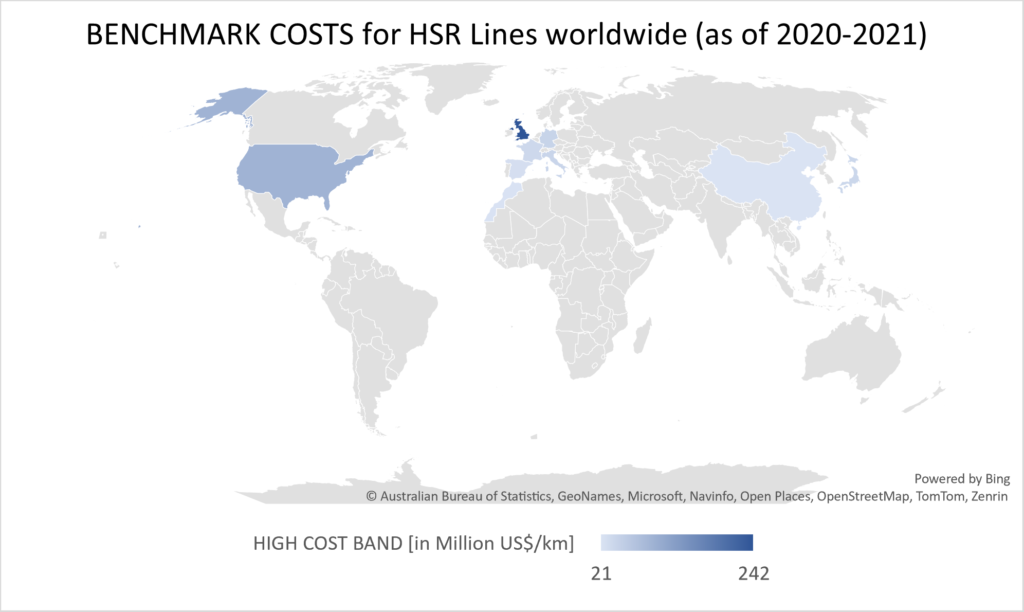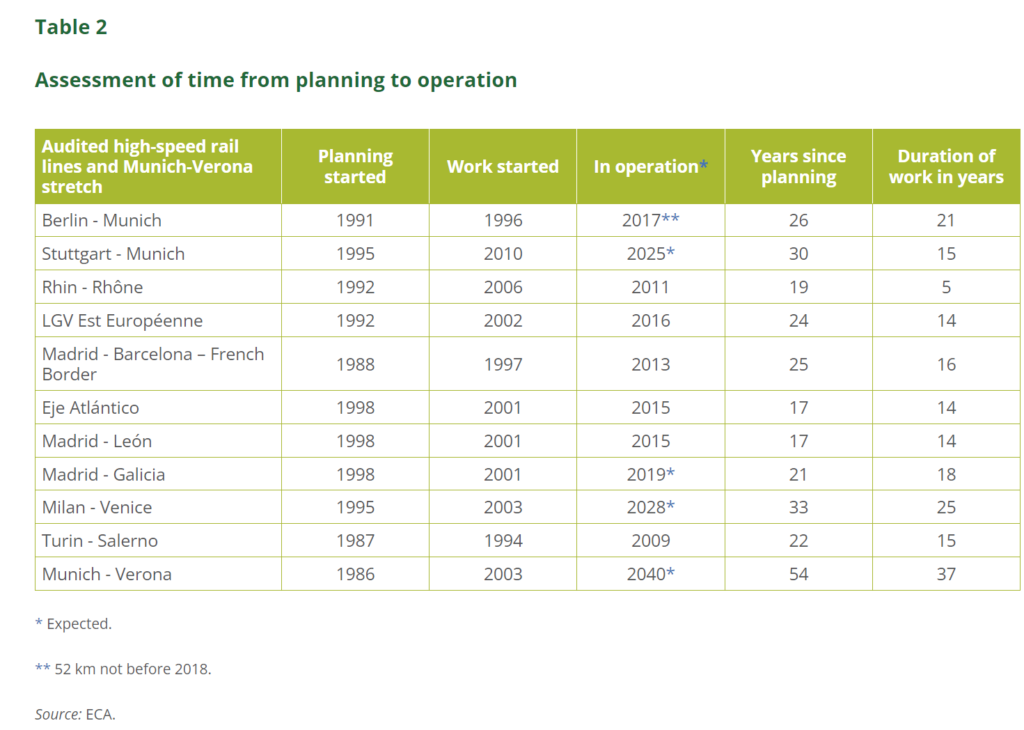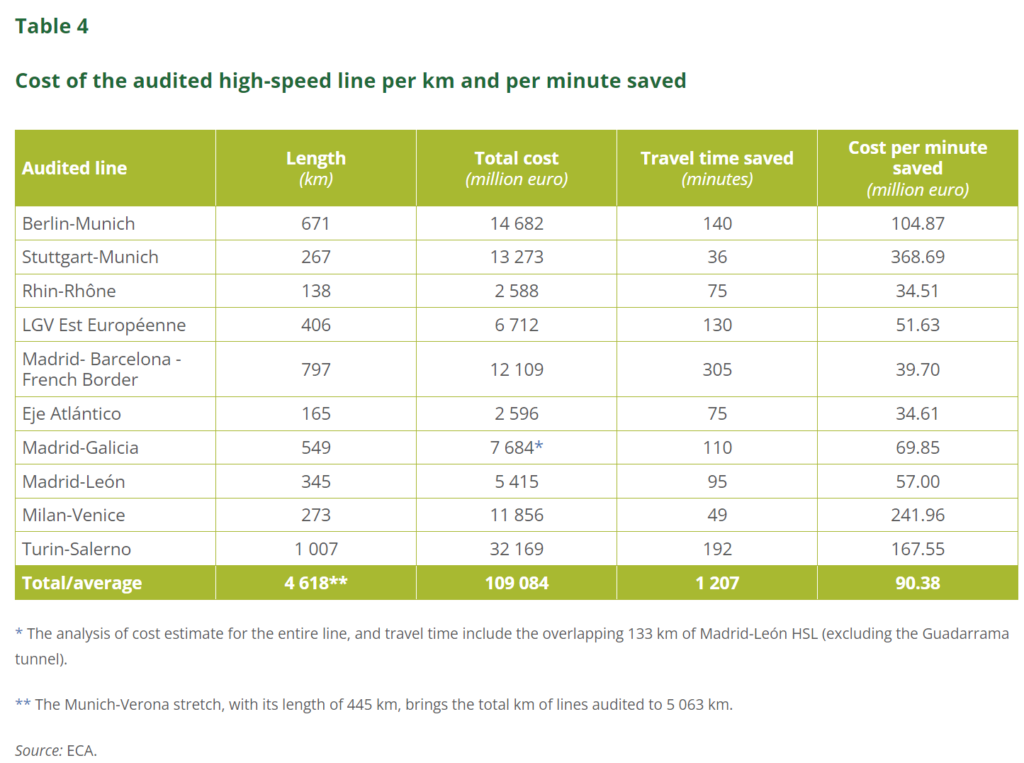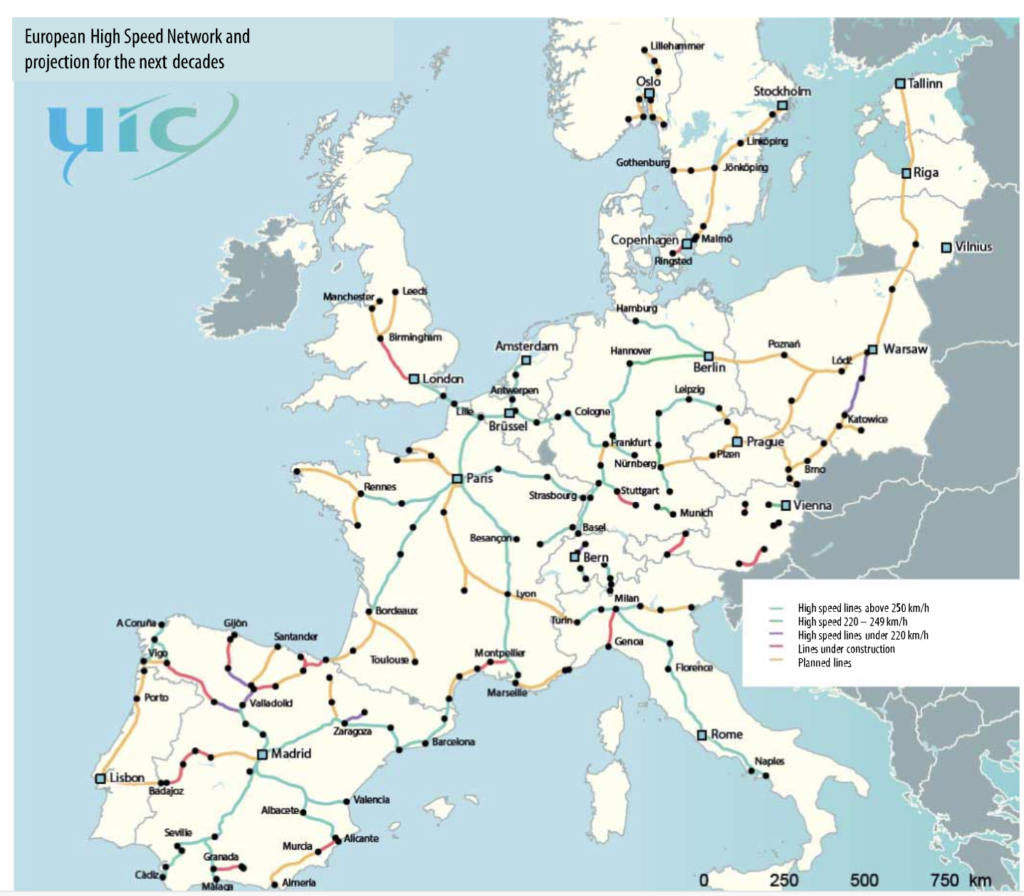Creating a long-term infrastructure pipeline investing in sustainable transport system connecting regional cities to Sydney with a brave visionary approach.
Remember the Sydney Opera House cost blowouts??…it’s a real landmark today for the country, promoting our arts, culture, and making it a ‘must see’ tourist attraction. Rewind the clock and the project – costed at 96 million initially experienced significant hurdles and challenges with costs estimated to be close to a billion dollars when referenced in today’s dollar value. Was it considered to be value for money at the time? Would the project still go ahead today with that kind of budget slip and such substantial delays…

Extremely high Infrastructure costs for HSR Lines around the World
The capital cost per kilometre for a High-Speed rail line varies significantly depending on various environmental, industry and planning factors such as terrain complexity (i.e., the need for tunnelling), construction challenges (i.e. site access difficulties), local labour costs, and whether it requires special planning process to buy land, approvals to convince local jurisdictions to the need to build tunnels, viaducts, or bridges.

On average, high-speed rail project delivery costs have ranged from USD $10-$100 million per kilometre around the world in recent years, with some key international projects (UK’s HS2 stage 1) well exceeding the higher threshold of USD $200 million (approx. AUD $300 million) per kilometre…Obviously, cost is dependent on many factors including geographic location, industry health and market workforce employment conditions, projects contracting models, land acquisition costs and stakeholder buy-in.
Looking at a worst-case international median benchmark cost per kilometre (from table #1 above) or USD $131 million (approx. AUD $200 million), it would make it a AUD $60 billion investment necessary looking at HSRA stage 1 of around 300km (roughly the distance between Sydney to Newcastle), which financially represents a share of 82% of the latest FY23-24 total 4-year transport investment budget in NSW. Now that’s what some would say putting all your eggs in one basket!
However, if you now look at the investment timeline to build such a project over a 12-year window for a 300km line would not be unreasonable right??…making the cashflow for the investment a reasonable 5 billion per year…ok so that now becomes approx. 25% of the share of the NSW transport infrastructure budget every year for 12 years. With that figure in mind, does that change shift the paradigm justifying transformative long-term investment to boost our economic growth.…This is where the Federal government needs to start setting the vision for enacting a HSR long term plan – not a 12-year plan – but a 40+-year plan to build a 1000km network. Why? Just have a look at the last 2023 Intergenerational report and economic outlook at 2063 (Intergenerational Report 2023 (treasury.gov.au) . It mentions a drop in our forecast economic growth “driven by lower projected population growth and slower long-term productivity growth”.
So, what can we do to alter this fate? Do we want to continue to attract some of the best young talents from all over the world to our country, embrace learning at our universities, and provide future opportunities to encourage them to stay and build a life here. Whatever the outcome, we need to turn things around to alter to our demographics from immigration and helping young families grow and prosper in the next 40 years, whilst at the same time improve productivity and affordability in this country. Infrastructure investment is only one of the levers but over the long-term steady increase in investments in infrastructure projects such as energy production, roads and rail will make greats strides for growing regional jobs, enabling sustainable long-term zero-emissions transport assets (albeit continuing to invest in green renewable energy production), and releasing the cost pressures on housing in Sydney and around the metropolitan areas, as there are many other benefits which would flow on from this. Not to mention we could link transport corridors with other major infrastructure programs including energy generation and connectivity to sustain our power strategy, housing along the corridor, investments in research and education as well as health to support an aging population. How can all these benefits be communicated and supported by all Australian citizens including regional populations? Let’s not kid ourselves, making the regions more attractive to the new demographics with affordable housing, jobs, and great cost of living incentives.
Let’s have a look at how two European countries (Spain and France – who collectively have built over 6,000 kms of HSR networks) have made their HSR become reality by leveraging some key policies over the last forty years.

Top 10 policies used by Spain and France to support the development of their respective HSR networks:
- Strong/unconditional Government backing: Both Spain and France had had strong government backing for the development of their high-speed rail networks, irrespective of the political party in power. The governments have provided specific funding, policy direction, and central coordination for the projects.
- Long-Term Planning (with special legislation approval for land release): Both countries had a long-term vision and plan for developing their high-speed rail networks together with special planning legislative frameworks. They created comprehensive plans that outlined the routes, infrastructural requirements, together with realistic project timelines over decades.
- Public Financing: Spain and France used public financing to fund the development of their high-speed rail networks. This allowed them to invest significant amounts of money into the projects without solely relying on private investment.
- Public-Private Partnerships: In addition to public financing, both countries formed public-private partnerships to facilitate the construction and operation of the high-speed rail networks. Private companies were involved in the construction, maintenance, and operations of the networks.
- Consistent coordination and Regional Cooperation: Spain and France fostered regional cooperation in the development of their high-speed rail networks. They collaborated with their respective regional jurisdictions, municipalities, and transport authorities to ensure a coordinated approach was supported and delivered at all levels.
- Industry collaboration in technology Innovation and Standardisation: Both countries sought technological innovation in their high-speed rail networks. They utilised the latest advancements in rail industry’s technology to ensure safety, efficiency, and speed would be possible in the market at competitive value.
- Focus on Intermodal Integration: Spain and France focused on integrating their high-speed rail networks with other modes of transport, such as local transit systems, airports, and highways. This allowed for seamless connections (like at airports) and improved passenger convenience.
- Promoting better International Connectivity: Both countries recognized the importance of international connectivity and aimed to connect their high-speed rail networks with neighbouring countries. This fostered cross-border travel and trade.
- Public Awareness and Education: Spain and France invested in public awareness and education programs to promote the benefits of high-speed rail. They conducted campaigns to educate the public about the advantages of HSR, such as reduced travel times, environmental benefits, businesses decentralisation, and regional economic growth.
- Enabling a future continuous expansion: Spain and France did not stop at the initial development of their high-speed rail networks. They continued to invest in expanding the networks, adding new routes, and increasing connectivity to more cities. This ensured the long-term viability and growth of the HSR networks.

So how does this all help Australia in developing it’s own HSR over the next few years as the major planning gets underway for the High Speed Rail Authority (HSRA) in Canberra.
Some take aways and measures for consideration:
- Planning HSR Infrastructure over a 50-year period is necessary, with a strategic plan including for financing, industry participation and planning and construction policies, and in a step by step approach
- Raising infrastructure contributions through funding schemes at all levels of government including LGA, State and Commonwealth combined with development value capture initiatives
- Exploring carbon-tax funding contributions from new taxes levied by Airlines and freight operators on the routes which are the most profitable in Australia or taxing profits on shareholder returns from the likes of Qantas…
- Using incentives for long term special infrastructure Bonds within Superannuation funds to raise special infrastructure contributions which can be used by government for borrowing long term at low-cost loans
- Passing special legislation to enforce transparent planning control measures over all parties including federal and state public and private land acquisitions for HSR ahead of time, with corridor reservations identified and enacted at concept stage, as well as imposing a maximum 12-month planning approval cycle to include third party and public consultation managed by the Commonwealth
- Working in partnership with infrastructure private/publicly listed companies to build up pipeline certainty over time to improve productivity in construction, with companies incentivised based on their profits to fund construction workforce recruitment and training over 40 years including commitments to hire more workers than the industry attrition rate forecasting.
- Attracting international and local private investments,
- Simplifying procurement schemes and reducing bidding costs for industry, while at the same time encouraging partnership models based on open book costs with specific target improvements required in the long term for local and international supply chains over time.
It is important to note that the suitability and effectiveness of some of these measures may vary depending on the specific context and financial & legal legislative frameworks within different states, countries or regions. So, what are we waiting for?..

